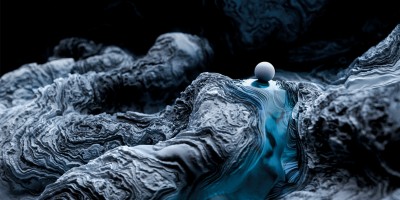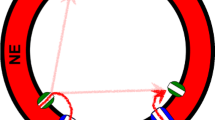Abstract
Calcium is a second messenger in virtually all cells and tissues1. Calcium signals in the nucleus have effects on gene transcription and cell growth that are distinct from those of cytosolic calcium signals; however, it is unknown how nuclear calcium signals are regulated. Here we identify a reticular network of nuclear calcium stores that is continuous with the endoplasmic reticulum and the nuclear envelope. This network expresses inositol 1,4,5-trisphosphate (InsP3) receptors, and the nuclear component of InsP3-mediated calcium signals begins in its locality. Stimulation of these receptors with a little InsP3 results in small calcium signals that are initiated in this region of the nucleus. Localized release of calcium in the nucleus causes nuclear protein kinase C (PKC) to translocate to the region of the nuclear envelope, whereas release of calcium in the cytosol induces translocation of cytosolic PKC to the plasma membrane. Our findings show that the nucleus contains a nucleoplasmic reticulum with the capacity to regulate calcium signals in localized subnuclear regions. The presence of such machinery provides a potential mechanism by which calcium can simultaneously regulate many independent processes in the nucleus.





Similar content being viewed by others
References
Berridge, M.J., Lipp, P. & Bootman, M.D. The versatility and universality of calcium signalling. Nature Rev. Mol. Cell Biol. 1, 11–21 (2000).
Pinton, P., Pozzan, T. & Rizzuto, R. The Golgi apparatus is an inositol 1,4,5-trisphosphate-sensitive Ca2+ store, with functional properties distinct from those of the endoplasmic reticulum. EMBO J. 17, 5298–5308 (1998).
Jouaville, L.S., Ichas, F., Holmuhamedov, E.L., Camacho, P. & Lechleiter, J.D. Synchronization of calcium waves by mitochondrial substrates in Xenopus laevis oocytes. Nature 377, 438–441 (1995).
Stehno-Bittel, L., Perez-Terzic, C. & Clapham, D.E. Diffusion across the nuclear envelope inhibited by depletion of the nuclear Ca2+ store. Science 270, 1835–1838 (1995).
Perez-Terzic, C., Pyle, J., Jaconi, M., Stehno-Bittel, L. & Clapham, D.E. Conformational states of the nuclear pore complex induced by depletion of nuclear Ca2+ stores. Science 273, 1875–1877 (1996).
Chawla, S., Hardingham, G.E., Quinn, D.R. & Bading, H. CBP: a signal-regulated transcriptional coactivator controlled by nuclear calcium and CaM kinase IV. Science 281, 1505–1509 (1998).
Hardingham, G.E., Chawla, S., Johnson, C.M. & Bading, H. Distinct functions of nuclear and cytoplasmic calcium in the control of gene expression. Nature 385, 260–265 (1997).
Pusl, T. et al. Epidermal growth factor-mediated activation of the ETS-domain transcription factor Elk-1 requires nuclear calcium. J. Biol. Chem. 277, 27517–27527 (2002).
Divecha, N., Rhee, S.-G., Letcher, A.J. & Irvine, R.F. Phosphoinositide signalling enzymes in rat liver nuclei: phosphoinositidase C isoform β1 is specifically, but not predominantly, located in the nucleus. Biochem. J. 289, 617–620 (1993).
Malviya, A.N., Rogue, P. & Vincendon, G. Stereospecific inositol 1,4,5-[32P]trisphosphate binding to isolated rat liver nuclei: evidence for inositol trisphosphate receptor-mediated calcium release from the nucleus. Proc. Natl Acad. Sci. USA 87, 9270–9274 (1990).
Allbritton, N.L., Oancea, E., Kuhn, M.A. & Meyer, T. Source of nuclear calcium signals. Proc. Natl Acad. Sci. USA 91, 12458–12462 (1994).
Lipp, P., Thomas, D., Berridge, M.J. & Bootman, M.D. Nuclear calcium signalling by individual cytoplasmic calcium puffs. EMBO J. 16, 7166–7173 (1997).
Fox, J.L., Burgstahler, A.D. & Nathanson, M.H. Mechanism of long-range Ca2+ signalling in the nucleus of isolated rat hepatocytes. Biochem. J. 326, 491–495 (1997).
Denk, W., Strickler, J.H. & Webb, W.W. Two-photon laser scanning fluorescence microscopy. Science 248, 73–76 (1990).
Williams, R.M., Zipfel, W.R. & Webb, W.W. Multiphoton microscopy in biological research. Curr. Opin. Chem. Biol. 5, 603–608 (2001).
Fricker, M., Hollinshead, M., White, N. & Vaux, D. Interphase nuclei of many mammalian cell types contain deep, dynamic, tubular membrane-bound invaginations of the nuclear envelope. J. Cell Biol. 136, 531–544 (1997).
Wamhoff, B.R., Dixon, J.L. & Sturek, M. Atorvastatin treatment prevents alterations in coronary smooth muscle nuclear Ca2+ signaling in diabetic dyslipidemia. J. Vasc. Res. 39, 208–220 (2002).
Malgaroli, A., Milani, D., Meldolesi, J. & Pozzan, T. Fura-2 measurement of cytosolic free Ca2+ in monolayers and suspensions of various types of animal cells. J. Cell Biol. 105, 2145–2155 (1987).
Lui, P.P.Y., Kong, S.K., Kwok, T.T. & Lee, C.Y. The nucleus of HeLa cell contains tubular structures for Ca2+ signalling. Biochem. Biophys. Res. Commun. 247, 88–93 (1998).
Leite, M.F. et al. Molecular basis for pacemaker cells in epithelia. J. Biol. Chem. 277, 16313–16323 (2002).
Clark, E.A. & Brugge, J.S. Integrins and signal transduction pathways: the road taken. Science 268, 233–239 (1995).
Reilly, J.F. & Maher, P.A. Importin β-mediated nuclear import of fibroblast growth factor receptor: role in cell proliferation. J. Cell Biol. 152, 1307–1312 (2001).
Lin, S.Y. et al. Nuclear localization of EGF receptor and its potential new role as a transcription factor. Nature Cell Biol. 3, 802–808 (2001).
Hagar, R.E., Burgstahler, A.D., Nathanson, M.H. & Ehrlich, B.E. Type III InsP3 receptor channel stays open in the presence of increased calcium. Nature 396, 81–84 (1998).
Zhu, Q.Q., Schnabel, W.E. & Schupp, H. Formation and decay of nitronic acid in the photoarrangement of o-nitrobenzyl esters. J. Photochem. 36, 317–332 (1987).
Gee, K.R., Wieboldt, R. & Hess, G.P. Synthesis and photochemistry of a new photolabile derivative of GABA. Neurotransmitter release and receptor activation in the microsecond time region. J. Am. Chem. Soc. 116, 8366–8367 (1994).
Oancea, E., Teruel, M.N., Quest, A.F.G. & Meyer, T. Green fluorescent protein (GFP)-tagged cysteine-rich domains from protein kinase C as fluorescent indicators for diacylglycerol signaling in living cells. J. Cell Biol. 140, 485–498 (1998).
Teruel, M.N. & Meyer, T. Parallel single-cell monitoring of receptor-triggered membrane translocation of a calcium-sensing protein module. Science 295, 1910–1912 (2002).
Oancea, E. & Meyer, T. Protein kinase C as a molecular machine for decoding calcium and diacylglycerol signals. Cell 95, 307–318 (1998).
Leite, M.F., Burgstahler, A.D. & Nathanson, M.H. Ca2+ waves require sequential activation of inositol 1,4,5-trisphosphate receptors and ryanodine receptors in pancreatic acinar cells. Gastroenterology 122, 415–427 (2002).
Deisseroth, K., Heist, E.K. & Tsien, R.W. Translocation of calmodulin to the nucleus supports CREB phosphorylation in hippocampal neurons. Nature 392, 198–202 (1998).
Carrion, A.M., Link, W.A., Ledo, F., Mellstrom, B. & Naranjo, J.R. DREAM is a Ca2+-regulated transcriptional repressor. Nature 398, 80–84 (1999).
Dobi, A. & Agoston, D.V. Submillimolar levels of calcium regulates DNA structure at the dinucleotide repeat (TG/AC)n . Proc. Natl Acad. Sci. USA 95, 5981–5986 (1998).
Gerasimenko, O.V., Gerasimenko, J.V., Tepikin, A.V. & Petersen, O.H. ATP-dependent accumulation and inositol trisphosphate- or cyclic ADP-ribose-mediated release of Ca2+ from the nuclear envelope. Cell 80, 439–444 (1995).
Phair, R.D. & Misteli, T. High mobility of proteins in the mammalian cell nucleus. Nature 404, 604–609 (2000).
Wojcikiewicz, R.J.H. Type I, II, and III inositol 1,4,5-trisphosphate receptors are unequally susceptible to down-regulation and are expressed in markedly different proportions in different cell types. J. Biol. Chem. 270, 11678–11683 (1995).
Xu, C., Zipfel, W., Shear, J.B., Williams, R.M. & Webb, W.W. Multiphoton fluorescence excitation: new spectral windows for biological nonlinear microscopy. Proc. Natl Acad. Sci. USA 93, 10763–10768 (1996).
Allbritton, N.L., Meyer, T. & Stryer, L. Range of messenger action of calcium ion and inositol 1, 4,5-trisphosphate. Science 258, 1812–1815 (1992).
Meyer, T. & Stryer, L. Molecular model for receptor-stimulated calcium spiking. Proc. Natl Acad. Sci. USA 85, 5051–5055 (1988).
Ramos-Franco, J., Fill, M. & Mignery, G.A. Isoform-specific function of single inositol 1,4,5-trisphosphate receptor channels. Biophys. J. 75, 834–839 (1998).
Acknowledgements
We thank B. Ehrlich for comments on the manuscript; T. Meyer for the GFP–PKC-γ construct and R. Wojcikiewicz for providing antibodies against the type II InsP3 receptor. This work was supported by an AASLD–Schering Advanced Hepatology Fellowship Award, a Glaxo Institute for Digestive Health Basic Science Research Award and a Yale Child Health Research Center Award (to W.E.); a grant from Conselho Nacional de Desenvolvimento Científico e Tecnológico (to M.F.L.); and NIH grants (to W.R.Z. and M.H.N).
Author information
Authors and Affiliations
Corresponding author
Ethics declarations
Competing interests
The authors declare no competing financial interests.
Supplementary information
Supplementary Figures
Figure S1. Limitations of conventional widefield UV excitation to examine the nucleoplasmic reticulum. (PDF 244 kb)
Figure S2. Visualization of the nucleoplasmic reticulum with mag-fluo-4.
Figure S3. Demonstration of the purity of the cytosolic and nuclear fractions.
Figure S4. A method for efficient localized photolysis of NPE-InsP3 using two photon excitation.
Rights and permissions
About this article
Cite this article
Echevarría, W., Leite, M., Guerra, M. et al. Regulation of calcium signals in the nucleus by a nucleoplasmic reticulum. Nat Cell Biol 5, 440–446 (2003). https://doi.org/10.1038/ncb980
Received:
Revised:
Accepted:
Published:
Issue Date:
DOI: https://doi.org/10.1038/ncb980
- Springer Nature Limited
This article is cited by
-
Distinct features of two lipid droplets types in cell nuclei from patients with liver diseases
Scientific Reports (2023)
-
CD38/ADP-ribose/TRPM2-mediated nuclear Ca2+ signaling is essential for hepatic gluconeogenesis in fasting and diabetes
Experimental & Molecular Medicine (2023)
-
Landscape of NcRNAs involved in drug resistance of breast cancer
Clinical and Translational Oncology (2023)
-
Grease in the Nucleus: Insights into the Dynamic Life of Nuclear Membranes
The Journal of Membrane Biology (2023)
-
Ca2+ mishandling and mitochondrial dysfunction: a converging road to prediabetic and diabetic cardiomyopathy
Pflügers Archiv - European Journal of Physiology (2022)





